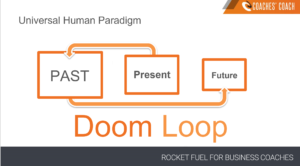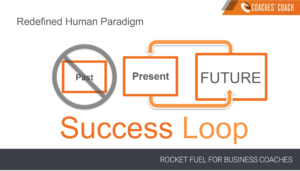
by Eric Dombach | Business Coach Training
Have you every been to one of these live events where everyone fawns over the most popular speaker that “wows” the audience with his or her dash-and-flash from the stage?
My friend Karl Bryan shared some interesting commentary on these media influencers recently…
Yes, they appear uber-impressive.
But here’s the life these event speakers actually live:
Pack bags.
Kiss kids and spouse goodbye.
Leave home with bags and jump into taxi.
Traffic.
Airport lineups and security.
Airport food.
Wait for flight in uncomfortable seat.
Line up to board.
Flight to first layover destination–no first class available, dude snoring next to you.
Wait to exit airplane.
Two-hour gap between flights.
More airport food.
Take a quick social media post on “winning” (be sure to use that crazy Charlie Sheen voice with the quote, “Dying is for amateurs”), making out like everything is totally off the charts, amazing in the video.
Wait for flight in another uncomfortable seat.
Line up to board final flight to destination.
Flight to final city.
Wait to exit airplane while dealing with some serious silent-but-deadly gas going on from someone up-wind of you.
Baggage claim for 30 minutes.
Jump in another taxi.
Lug bags to hotel room.
Unpack and iron clothes for tomorrow.
Crawl into hard bed (alone) with bad pillows.
Wake up.
Find conference room.
Create another social media video on “winning.”
See some “fans” and take some pics.
Wait to go on stage (they’re always running late).
Perform the same stale speech with more video testimonials than actual content…
Close and ask people to buy.
Count “time for money” cash (minus the 50% the organizer takes off the top, plus the costs of flight, hotel, taxi, dinner, drinks, etc.).
Say goodbye and take more pics and “winning” vids for social media.
Now repeat the whole process to get home.
Or, if you’re a really good influencer, continue on for a three- to ten-event tour.
Give Yourself a Better Life
Next time you see the Influencer on social media or on stage, ask yourself: “Is that really what I want? Is this really the right person I should aspire to be?”
Your mileage may vary, but as far as my answer?
HARD. PASS.
Said otherwise: Going the wrong direction enthusiastically is not a great idea.
Going the wrong direction enthusiastically is not a great idea.
Ask yourself: what life do you really want?
What actually matters?
Don’t get caught up in the fake flash of social media influencers.
I learned how to make $500,000 a year as a business coach at home with a phone, Zoom, passion, and some mojo–and I haven’t looked back since.
You can too.
What’s it gonna be, coach?
Business coaching gives you a rock star lifestyle without the hassle. Check out our FREE ebook, Secrets of a Business Coaching Rock Star, to learn how to make it in your life.

by Eric Dombach | How to Become a Business Coach
When I started out as a business coach, I had very little in the way of professional experience or entrepreneurial acumen. I was low on cash and terrified this wouldn’t work out.
But I also knew that $30,000 a year wasn’t going to feed my family, so I put my heart and soul into building something of value.
Maybe it’s the time of year, when Thanksgiving has me thinking about all the things I have to be grateful for, but I want to share with you the single most important shift I made in my mindset to get over the fear and self-doubt.
It’s something I think about a lot–especially when it comes to working with business coaches who are just starting out. But it’s also extremely relevant for business coaches who are feeling worn down and weary.
And that is this simple reminder:
To forge the future, we must first reframe the past.
Which “Loop” Are You Stuck In?
So often, we spend all our time reliving the failures of the past–which of course impacts the way we create the future. I call this the “doom loop” and it’s near-universal.

To break free, we need to reorient ourselves to the present–with an eye to what’s coming next. I call this the “success loop” and it’s an incredibly important paradigm shift to make.

But How?
It starts here: To forge the future, we must first reframe the past.
Let me give you an example from my early business coaching days. As a young man with no business experience, leaving my full-time job as a pastor, I had all sorts of anxieties:
- No professional sales background
- No personal business network
- No business ownership experience
- No P&L experience
- Young and inexperienced
- No money and a lousy car
- No business coaches anywhere in the community
I could have continued to tell myself a story about how what I was trying to achieve was impossible because I didn’t have the skillset or experience to succeed–but I was in a situation where failure wasn’t an option.
So I decided to find the benefits of my situation and focus there instead.
The result? It drove me out of the doom loop into the success loop with just a few simple reframes.
I could have continued to tell myself a story about how what I was trying to achieve was impossible because I didn't have the skillset or experience to succeed--but I was in a situation where failure wasn't an option. So I decided to find the benefits of my situation and focus there instead.
See for yourself.
- No sales background –> No bad sales skills to unlearn!
- No personal business network –> I can completely forge a new identity in the community.
- No business ownership experience –> I won’t be held back by bad experiences.
- No P&L experience –> I’ll be very conservative about money.
- Former pastor –> Good at working with people and sensitive situations.
- Young and inexperienced –> I’ll run circles around the older guys, and see possibilities they’re too jaded to imagine!
- No money and a lousy car –> I’m hungry and hard-working.
- No business coaches anywhere in the community –> I have the space to create a market-driven movement.
Now you try. No matter where you are in your business coaching journey–whether you’re just starting out or you have some hard-won experience under your belt–this Thanksgiving, take the time to reframe some of what’s been dragging you down so that you can move on into a brighter, more successful future.
And if you’re brand new to business coaching, might I suggest my FREE ebook, How to Become a Business Coach? It’ll walk you through the entire process of getting your practice off on the right foot. Enjoy!

by Eric Dombach | Business Coaching Systems
Have your webinars become a little ho-hum?
Maybe you’re not pulling in the numbers you used to. Perhaps you’ve even given up, because it’s the usual suspects time after time–existing clients or tire-kickers whose presence doesn’t help you close new coaching contracts.
Yet webinars remain one of the most effective ways to generate business IF you know how to do them right. Follow my simple 4-step formula to get back on track!
Build Your Database
If you’re low on participants, it’s probably because you’re low on prospects. You should always be driving new contacts to your database, because webinars are fantastic at warming up cold leads. Not sure how? Try these tactics:
- Use LinkedIn and Facebook groups to network and connect with business owners in your target market.
- Create a lead magnet, such as an ebook (or even a previous webinar you recorded!) to populate your database.
- Use Facebook or LinkedIn ads to drive traffic to your webinar registration page.
Market Your Webinar Well
Maybe your list looks okay, but your copy just isn’t converting. No problem, I solved that for you. Swipe my proven formula for filling webinars!
The main things to remember are that you should include highly educational, value-added emails as part of your marketing process. Don’t just pitch–educate!
Another way our team improved our show rate from 25% to 40% was to have sales staff pre-call each registrant before the webinar to get to know them better.
Update Your Presentation Regularly
Whatever you do, don’t rehash the same tired content you used last year–or, heaven forbid, last decade. You don’t have to entirely reimagine your presentation every time you host a webinar, but you should be updating your presentation with current anecdotes, stats, insights, graphics, and examples.
Whatever you do, don't rehash the same tired content you used last year--or, heaven forbid, last decade. You don't have to entirely reimagine your presentation every time you host a webinar, but you should be updating your presentation with current anecdotes, stats, insights, graphics, and examples.
If your presentation looks like it was built in 2008, well then…

Crush Your Follow Up
After the call, download the webinar attendance list from Zoom and sort based on engagement. Send the recording to those who asked for it. Conduct your Complimentary Coaching Sessions with everyone who booked one, then reach out to all registrants to invite them to a follow-up conversation.
Most importantly, track your progress over time. Take note of which topics seemed to hit and which messages seemed to convert so that you can iterate and refine your process over time.
Did you know that I have a complete webinar system that you can swipe? It’s only for members, though–so get your FREE 30-day trial in our membership site to see exactly what tools, sales scripts, and templates we use to create killer webinars our prospects love!

by Eric Dombach | Business Coach Training
I’ve shared before that there are three killer constraints that will absolutely destroy your success as a business coach.
No matter how skilled you are, if you struggle with any of these, it will be very difficult to create the business coaching practice you’re hoping for.
They are:
- “Pushover” tendencies: Difficulty persuading, convincing, and winning others over to your point of view.
- “Softie” tendencies: Difficulty evaluating and critiquing the work of others and carrying out crucial confrontations.
- “Quitter” tendencies: difficulty persevering and following through on commitments in the face of difficulty.
Now, don’t get me wrong. Just because you struggle with some of these tendencies doesn’t mean there’s no hope. I’ve worked with countless business coaches who have had to work hard to build the confidence it takes to succeed–both in terms of sales and coaching. The fact of the matter is that everyone has personal constraints. The process of growth simply means identifying, addressing, and removing them, so that you can reap incremental gains in performance.
The fact of the matter is that everyone has personal constraints. The process of growth simply means identifying, addressing, and removing them, so that you can reap incremental gains in performance.
And the best way to do that is to practice.
What are some simple ways you can begin to remove your killer constraints?
Try these exercises.
14 Simple Practices to Increase Your Confidence
- Assert yourself in daily routine decisions versus deferring to others. For example, be the one to pick the place for lunch or dinner!
- Give critical feedback that is direct and unambiguous.
- Take up a directly competitive sports hobby where you are forced to compete and win.
- When confronted with a moment in which your default is to defer, deflect, avoid, or quit, ask yourself “why?” at least five times to dig deeper and discover the emotional roots to behavioral patterns.
- Create high-stakes accountability for non-performance of critical sales and business development activities. For example, commit to “bold-walking” (visiting) 100 business in 7 days or pay an accountability partner $500.
- Use decisive language: “We can absolutely help you win!” versus “Well, we might be able to help you. I mean, I can’t guarantee anything….”
- Roleplay Complimentary Coaching Sessions with various detailed scenarios and aggressive objection handling situations.
- Take a stand-up or improv comedy class to learn how to “say yes” and think on your feet.
- Celebrate every single win for an entire week, no matter how big or small–with your clients, your family, and yourself.
- Genuinely encourage one person a day.
- Pay it forward with a random act of tangible kindness every day for a month.
- Create an accountability/competitive relationship with another coach and set daily sales and performance targets with a weekly financial pot (for example, $50 total – $25 each) and bragging rights.
- Keep a daily gratitude journal in order to focus on all of the things you are grateful for in life — versus the self-critical and negative aspects of life.
- Turn “NOs” into a game: if you can get 25 “NOs” within one month, you celebrate in a special way. This is much harder than it sounds!
Remember: you don’t have to hit it out of the park. The best way to improve is to approach it slowly but steadily–with daily practices and habits that change your behavior and therefore results. Pick one to start and see what a difference it makes!
And for more great ways to shift your mindset and maximize your results, download our FREE ebook, Secrets of a Business Coaching Rock Star.

by Eric Dombach | How to Become a Business Coach
If you’re preparing to start or grow your business coaching practice, I want you to think deeply about one of the most important concepts in the business of business coaching: the Effective Billable Rate, or EBR for short.
From an earning perspective, the EBR is the million-dollar difference between consulting and true business coaching. Many new business coaches confuse business coaching with business consulting, but they’re not the same–and believe me, business coaching is the far better gig. In general, consultants base their work on hourly rates and deliverables, not on value, and definitely not on results. A coach, on the other hand, is a valued teacher, mentor, motivator, and educator, and is paid based on value and results. Keep this perspective in mind as we head into this conversation about the effective billable rate.
Business Coaching Is a Top-Earning Profession
Business coaching is not based on an hourly rate. You should set up your contracts so that you get paid a monthly retainer to deliver results. Even still, you should pay attention to your effective billable rate to help you keep track of how efficiently you’re operating your business.
The typical business coach has anywhere from 10 clients to 15 clients at a time, depending on the experience level, each of whom is investing anywhere from $1,000 to $3,000 per month. In return, the coach typically spends 30-60 minutes coaching each client per week. In revenue terms, that’s $10,000 to $45,000 per month in cash flow for 5 to 15 hours of client-facing work each week. At the high end, that’s $750 per hour.
This puts business coaching at the very top of the list for top-earning professionals. Compare that sort of revenue to anesthesiologists, surgeons, chief executives, engineers, attorneys, and so on. Business coaching leaves other professions in the dust–and that’s especially true because you get to keep the profits. You don’t have to share them with a medical practice, engineering firm, or law firm. You don’t have to pay back exorbitant student debt. You can work from the comfort of your home office.
You’ll never generate that kind of income as a consultant because consulting involves providing deliverables based on an hourly rate, no matter how specialized you become. That’s because, as a coach, you’re not trading your time for their money. You’re trading your knowledge for their money––and as long as they get the value and results they expect and need and deserve, it’s a win/win. By the way, this is the beauty of business coaching and I hope you’re pretty pumped about it.
As a coach, you’re not trading your time for their money. You’re trading your knowledge for their money––and as long as they get the value and results they expect and need and deserve, it’s a win/win.
Having said all that, setting up your coaching programs to maintain a high effective billable rate can be a bit tougher than it sounds and takes some careful planning and analysis.
Expected Billable Rate vs. Effective Billable Rate
First, understand the difference between your expected billable rate and your effective billable rate. The expected billable rate is the amount per hour that you receive for actual coaching time (as in our example above of $750/hour). Of course, the time you spend in coaching sessions is only part of the equation. Thus, you should calculate your effective billable rate as the actual, real rate you’re making per hour based on actual, real time you’re investing in your clients when you include all the other things you do to service them.
Let’s say you have a one-on-one coaching client who pays you $1,000 every month for 30 minutes of coaching per week. Your expected billable rate is $465. Great, right? Not so fast. Let’s say you add up the time associated with all the rookie inefficiencies and wasteful habits I see coaches making all the time: extra-long emails about things that should be handled on coaching calls, unplanned bonus phone calls, extra-long coaching sessions that are more educational and teaching in nature because you don’t have a membership site, inefficient billing and collecting practices, and, God forbid, even driving time to see your clients (which you should NEVER do in this age of Zoom or video conferencing!). Do all this, and you can easily add a whole additional hour per week!
Now you’ve got $1,000 divided by 6.45 hours per month—and all of a sudden you’ve gone from $465 per hour to $155 an hour, or about a third of your expected billable rate! That’s decent, but you’re no longer in the top-tier of income-earning professionals. On top of that, you’re spending more time than you need on inefficient client services, and you’re behaving more like a consultant than a coach.
How to Improve Your EBR
Your goal should be to stay in the $250-$500/hour range for your effective billable rate. Here’s how to improve your efficiency:
- Never answer an email that requires more than a paragraph or stay on the phone for more than a minute or two with an unexpected call. If it’s going to require more, defer and say, “Hey, we’re gonna have to do this in our next coaching session.”
- Always bill upfront. You shouldn’t be chasing money. Payments are collected the day your contract is signed, and are for the coming month–NOT the previous one.
- Use automated billing. Make a decision that you simply don’t accept checks or other forms of payment that must be handled manually, but instead automate the process so that the retainer is deducted automatically from their credit card or bank account.
- Have a membership site. Have all the basic content you teach your clients in a membership site (like the one we have at the Coaches’ Coach), and assign clients the learning materials they need to study in advance of your coaching session. That way, you’re not spending your time teaching concepts, but coaching them on the implementation of the concepts they’ve already learned. Do this, and you can keep your calls to just 30-45 minutes!
- Never drive to weekly coaching meetings. It’s such an extraordinary waste of time and you don’t need to do it in an age where you can use technologies like Zoom to enjoy verbal, vocal, and visual interaction with your client. The only possible exception to this rule is if you’re holding a day-long training session with your client’s team. Even then, you can accomplish that virtually as well.
Want to build a business coaching practice with an EBR so high it’d make doctors and lawyers blush? Download our FREE ebook, How to Become a Business Coach, to get your business started.
Page 7 of 22« First«...56789...20...»Last »








